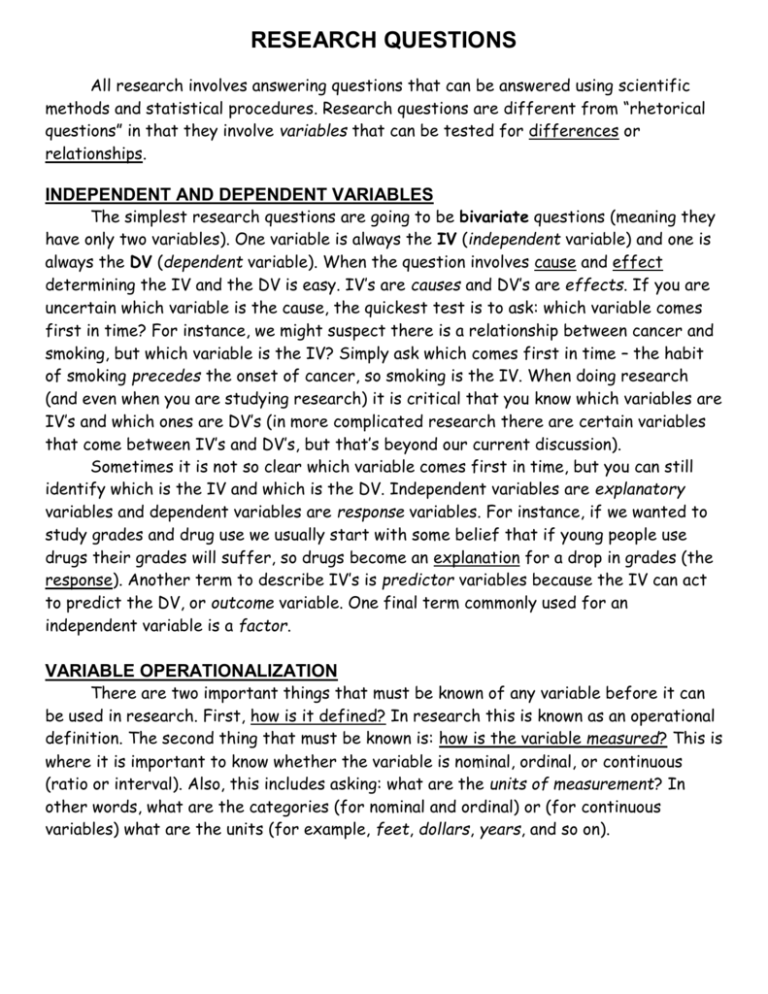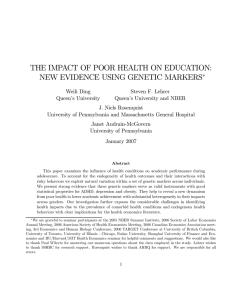RESEARCH QUESTIONS
advertisement

RESEARCH QUESTIONS All research involves answering questions that can be answered using scientific methods and statistical procedures. Research questions are different from “rhetorical questions” in that they involve variables that can be tested for differences or relationships. INDEPENDENT AND DEPENDENT VARIABLES The simplest research questions are going to be bivariate questions (meaning they have only two variables). One variable is always the IV (independent variable) and one is always the DV (dependent variable). When the question involves cause and effect determining the IV and the DV is easy. IV’s are causes and DV’s are effects. If you are uncertain which variable is the cause, the quickest test is to ask: which variable comes first in time? For instance, we might suspect there is a relationship between cancer and smoking, but which variable is the IV? Simply ask which comes first in time – the habit of smoking precedes the onset of cancer, so smoking is the IV. When doing research (and even when you are studying research) it is critical that you know which variables are IV’s and which ones are DV’s (in more complicated research there are certain variables that come between IV’s and DV’s, but that’s beyond our current discussion). Sometimes it is not so clear which variable comes first in time, but you can still identify which is the IV and which is the DV. Independent variables are explanatory variables and dependent variables are response variables. For instance, if we wanted to study grades and drug use we usually start with some belief that if young people use drugs their grades will suffer, so drugs become an explanation for a drop in grades (the response). Another term to describe IV’s is predictor variables because the IV can act to predict the DV, or outcome variable. One final term commonly used for an independent variable is a factor. VARIABLE OPERATIONALIZATION There are two important things that must be known of any variable before it can be used in research. First, how is it defined? In research this is known as an operational definition. The second thing that must be known is: how is the variable measured? This is where it is important to know whether the variable is nominal, ordinal, or continuous (ratio or interval). Also, this includes asking: what are the units of measurement? In other words, what are the categories (for nominal and ordinal) or (for continuous variables) what are the units (for example, feet, dollars, years, and so on). RESEARCH QUESTIONS In this course we want to be able to construct BIVARIATE research questions. These can be either DIFFERENCES questions or RELATIONSHIPS questions or any combination of both. The type of question you ask will be driven primarily by the types of variables you have. DIFFERENCES questions are shaped this way: “Is there a difference between [categories of the IV] based on [the DV]." You must also indicate the UNITS OF ANALYSIS in your question. The IV must be a discreet variable; the DV can be either discreet or continuous. If the independent variable is a categorical (discreet) variable, then you must develop a DIFFERENCES question. For example: “Is there a difference between college students who are liberal and college students who are conservative based on racism?” The independent variable in this question might be named something like POLITICAL PERSUASION. There are two categories: Liberal and Conservative. The dependent variable is RACISM. The units of analysis in this question are COLLEGE STUDENTS. Another example: “Is there a difference between men and women based on smoking?” Note two things about the question. First, in a case such as this you do not need to state the units of analysis because it is clear that men and women are people—the units of analysis are so obvious that to state that in the question would be silly. Second, there is no need to state the categories of the dependent variable. RELATIONSHIPS questions are shaped this way: “Is there a relationship between [the IV] and [the DV].” Remember, you must include the UNITS OF ANALYSIS. Relationships questions require that both the independent and dependent variables be continuous variables. For example: “Is there a relationship between amount of student loans and depression in college students?” For this question the IV is STUDENT LOAN AMOUNT (presumably in dollars) and the DV is DEPRESSION (as measured by an index that produces a depression score). Both variables are scores derived from an index, and both variables are continuous. The units of analysis are, once again, COLLEGE STUDENTS. REMEMBER TO ALWAYS STATE YOUR INDEPENDENT VARIABLE FIRST.






